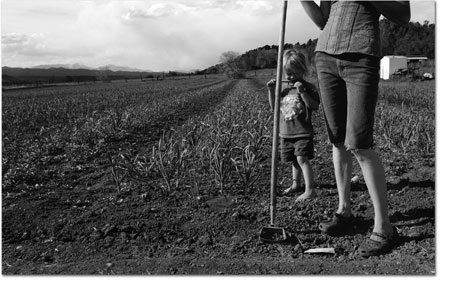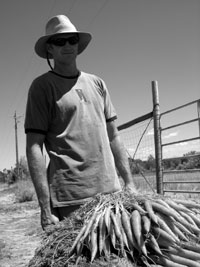|
| ||||||
| In the market
by Jeff Mannix
“I don’t believe that food is meant to be made in a factory, and I think people are getting hip to that,” says Chuck Barry of Stone Free Farms, a grower and one of the originators of the local market. “Vegetables from our local grocery stores have traveled an average of 1,500 miles to be displayed for sale. Our vegetables are harvested 24 to 36 hours before you buy them at the market.” Barry then adds, “It’s not hard to figure out which product delivers the most nutrients, is it?” Alison Dance, owner of Durango’s Cyprus Cafe, takes great pains to buy as much locally grown food as she can. “It’s a feel-good thing for me,” says Dance, “and it’s absolutely necessary in this industrial world to start being self sufficient, to think and act locally.” This is no easy task for a restaurateur, Dance sighs. There are just not enough local growers to supply produce for the restaurant even during the growing season, and growing in hothouses is expensive. “I just can’t call in and order for five boxes of spinach and expect it to be at my back door in the morning,” says Dance. “These growers are family farms with 1 or 2 acres in crops; they work the fields from sunrise to beyond sunset seven days a week, and I can’t expect them to harvest product just for me and then deliver it, much less discount prices.” So Dance is the first shopper at the Durango Farmer’s Market each Saturday, buzzing though the aisles and filling up bags of vegetables to get her restaurant through the week. “And even though I do this to satisfy my desire to serve the freshest, ethically grown food to my customers and to support a sustainable economy, frankly, I have seen my restaurant doing better since we’ve been serving these artisan foods,” she says. The trend toward locally grown food is actually a chronological step backward in the United States. The fast food phenomenon started sweeping the country in the 1940s, and multinational corporations soon accumulated vast tracts of farmland to grow the required cheap ingredients. Local farmers who had always supplied fresh, ethically produced food to nearby markets were driven out of business by escalating land prices and the predatory pricing of the giant industrial farms, abetted by the huge subsidies in the federal farm bill.
However, there is now a thriving “Slow Food” movement here and in Europe, driven by the consumer who feels our food supply is adulterated to the point of being poisonous. “Come on,” says Farmer’s Market shopper Mike Smedley, “who wouldn’t want to buy food that is fresh with nutrients and grown by your neighbor and makes our economy strong and diversified? It’s something we can do that’s healthy for us and healthy for our community. That’s a no-brainer as far as I’m concerned.” Smedley then adds, “There’s just no comparison in the taste between fresh-picked produce and locally grown meats and the hyped-up junk you buy at City Market or Albertson’s. And now with the price of fuel used on these factory farms and the cost of chemicals necessary to grow crops on the denuded soil, plus the cost of more fuel to get old produce and mushy beef and antibiotic-laden chickens to market, the price of fresh, locally grown food is no more expensive. What are people missing in this story?” What many people may be missing is an understanding of the farm bill that undergoes an adjustment every five years in Washington, D.C., and at this moment is being massaged for the next half-decade. The farm bill supports prices of five commodities, corn, soybeans, wheat, rice and cotton, three of which – corn, soybeans, wheat – attract $25 billion a year in federal largess. For the last several decades, U.S. agricultural policy has been designed in such a way as to promote the overproduction of these five commodities, especially corn and soy. An increasing number of critics believe the mystery of ballooning American waistlines and diabetes and cancer epidemics might possibly be solved by reflecting on the farm bill and the over-processed food it promotes. The mishmash of incentives and disincentives built into the farm bill decides what happens on nearly half the private land in America. As excess commodities are dumped on world markets, the cost of food in the U.S. is kept artificially below the cost of production. Meanwhile, critics argue, goods made from farm bill subsidies continue to despoil millions of acres of farmland, defile the air and gobble up fossil fuel. However, the source of food, growing practices and concern over ingredients are becoming increasing concerns to American consumers these days. It was the consumer, after all, who grew the $15 billion organic-food industry and nearly doubled the number of farmer’s markets – from 2,750 to 4,500 – in the last five years. It was the consumer, voting with his fork, who caused fast food giants like Burger King to institute animal welfare policies regarding purchase of eggs, chicken and pork, and the impeachable Wal-Mart and other grocery chains to redesign labels to attract buyers seeking wholesome food. And it is the consumer who has coined the phrase “ethical eating,” meaning, according to Deena Goldman, a director at Slow Food USA, “good, clean and fair” food. Tom and Sarah Buscaglia are a young, idealistic couple with three young kids who farm a couple of acres in the Sunnyside area south of Durango. They make their living toiling in the soil to feed their family by feeding other families. “This is the noblest profession,” Tom exclaims, “and what we do with our lives and how it affects others is at the root of why Sarah and I work this hard.” Tom believes that growing crops by hand, knowing that others will benefit from his labors, is basic to nature and his contribution to fixing a world seemingly intent on self-destruction. Dan James, president of the Durango Farmer’s Market and maker of James Ranch artisan cheeses, feels he and his family are doing the right thing and working for a greater purpose. “It’s the food consumer that’s going to make this transition to local independence happen,” predicts James. “It’s evolution – natural selection – you have to evolve to survive, and local food sustainability is achievable. We need more local artisan growers, but we’re way ahead of most other communities with that goal.” Sustainability is at once the hope and curse of the local artisan agriculturist. Although the market can sustain a local food economy, as Durango’s can, often land is priced beyond the grasp of the producer. “We need landowners to give an acre or two to a young grower,” says James, “and in return, they’ll give the community independence, healthy food and enjoy seeing the practice of one of man’s noblest enterprises.” •
|



 Twenty-four weeks of locally grown food and fiber kicks off in Durango this Saturday. The 12th annual Durango Farmer’s Market launches its summer season on May 19. Joining a wave of popularity in America and Europe, the Durango market is showing that the farmer’s market is more, much more, than simply an outdoor grocery store.
Twenty-four weeks of locally grown food and fiber kicks off in Durango this Saturday. The 12th annual Durango Farmer’s Market launches its summer season on May 19. Joining a wave of popularity in America and Europe, the Durango market is showing that the farmer’s market is more, much more, than simply an outdoor grocery store.
